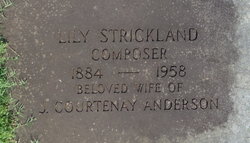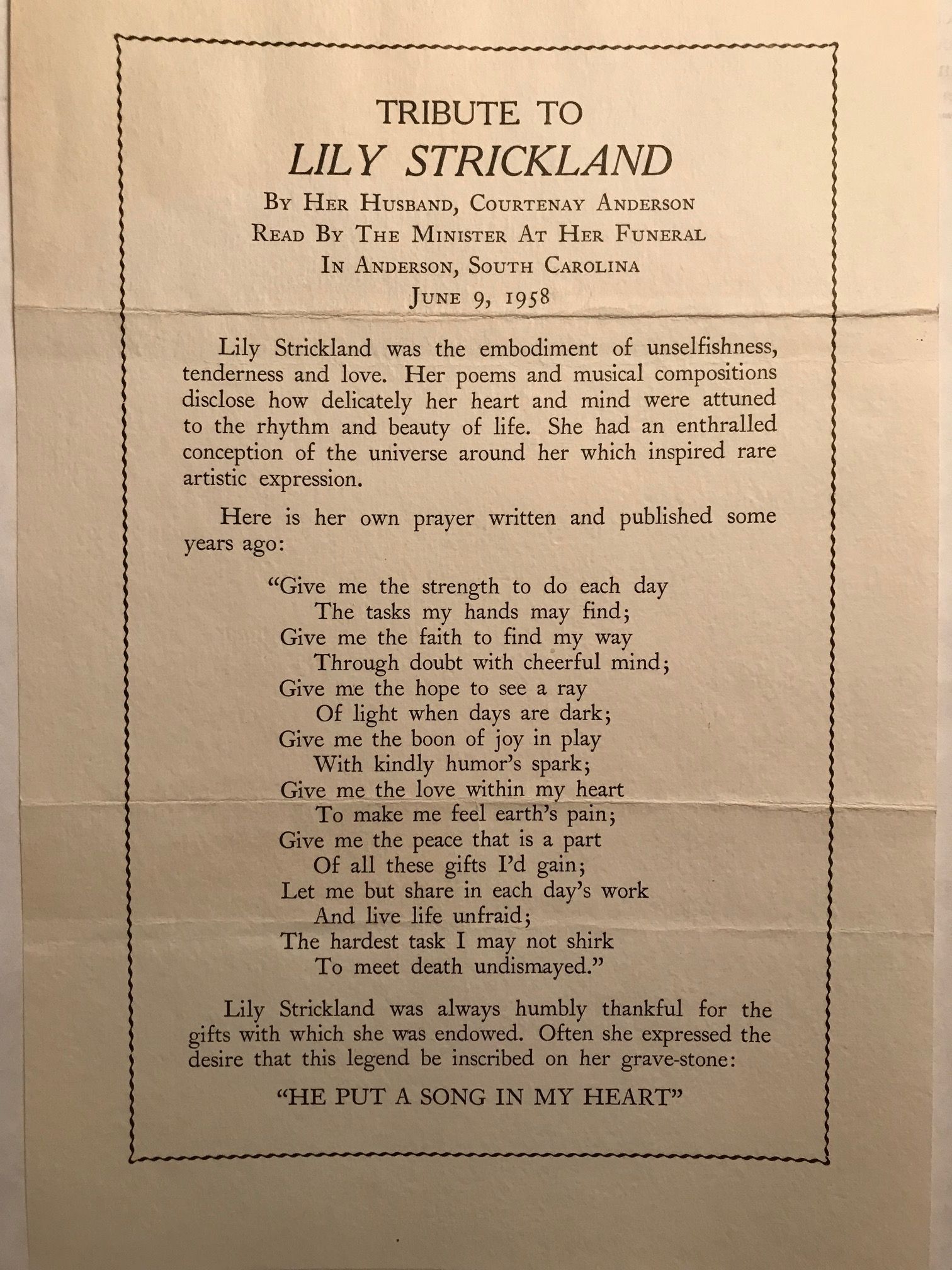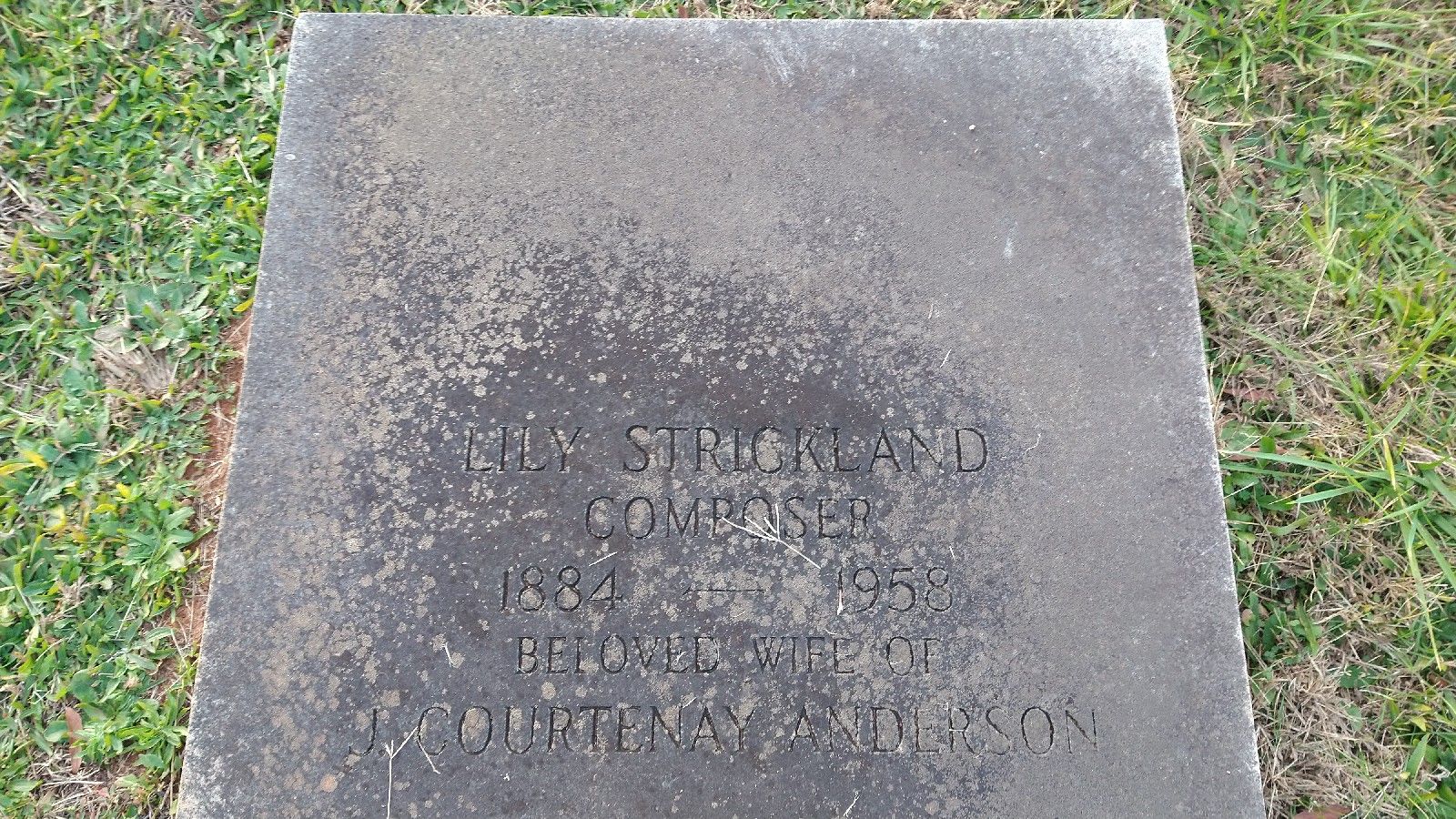From the South Carolina Encyclopedia as written by Melissa Walker and in the public domain.
Strickland, Lily
1884—June 6, 1958
Composer, writer, artist. Strickland was born in 1884 in Anderson, the only daughter of Charlton Hines Strickland, an insurance salesman, and Teresa Hammond Reed. Her father died when she was young, leaving Lily and her brothers to grow up in the Anderson home of their maternal grandparents, Judge and Mrs. J. Pinckney Reed.
Lily attended Anderson schools and began studying piano at the age of six. Encouraged by her family to pursue her musical ambitions, she published her first composition while still in her teens and studied piano and composition at Converse College from 1901 to 1904.
In 1905 she received a scholarship for study at the Institute of Musical Arts in New York (the forerunner to Juilliard). In New York she met Joseph Courtenay Anderson, a fellow South Carolinian and a Wofford graduate who taught English at Columbia University. The two married in 1912. They never had children.
Strickland (who used her maiden name professionally) spent the rest of her life composing, writing, and painting all over the world as she followed her husband to his various jobs. In 1920 Courtenay Anderson became manager of the Calcutta branch of an American company. The couple spent most of the next ten years in India. During these years Strickland journeyed all over Africa and Asia, composing, painting, and writing. Her travel essays appeared in numerous American magazines, and her watercolors graced the covers of her sheet music.
Strickland enjoyed breaking free of traditional restraints on women imposed by southern culture. After one five-week journey in India, she wrote to her goddaughter about a treacherous trip on a mountain road with a reckless driver: “Strange to say, I enjoyed it. . . . [A]fter so many years of repression and narrow-minded negations, I have just ‘busted lose’ [sic] and become a Fatalist.”
A prolific composer, Strickland published 395 musical works for popular, church, and children’s performances. Her early works displayed the influences of life in the Jim Crow South, incorporating numerous elements of African American spirituals and folk music and the rhythms of southern speech. Her later compositions were inspired by the music she heard in Asia and Africa.
She enjoyed wide popularity, an unusual accomplishment for a female composer in the early twentieth century. Numerous ensembles, including the New York Philharmonic, the Charleston Symphony, and the Metropolitan Opera Orchestra, performed her work, as did such artists as Burl Ives and Paul Robeson.
Her most famous composition was a popular piece with a southern flavor, “Mah Lindy Lou.” In recognition of her accomplishments as a composer, Converse College conferred an honorary doctor of music degree on her in 1924.
After returning to the United States, Strickland and her husband lived in New York until 1948, when they retired to a farm near Hendersonville, North Carolina. Strickland continued to compose and write until her death of a stroke on June 6, 1958.
References:
Howe, Ann Whitworth. Lily Strickland: South Carolina’s Gift to American Music. Columbia, S.C.: R. L. Bryan, 1970.
Kinscella, Hazel Gertrude. “An American Composer at Home.” Better Homes and Gardens 16 (September 1937): 60, 94–97.
Strickland, Lily. Papers. Converse College Archives, Spartanburg, South Carolina.
[Note: there is also a chapter, pp 99-107, about Lily Strickland, in the book More than Petticoats: Remarkable South Carolina Women, by Lee Davis Perry, published by Rowman & Littlefield 10 Feb 2009]
From the South Carolina Encyclopedia as written by Melissa Walker and in the public domain.
Strickland, Lily
1884—June 6, 1958
Composer, writer, artist. Strickland was born in 1884 in Anderson, the only daughter of Charlton Hines Strickland, an insurance salesman, and Teresa Hammond Reed. Her father died when she was young, leaving Lily and her brothers to grow up in the Anderson home of their maternal grandparents, Judge and Mrs. J. Pinckney Reed.
Lily attended Anderson schools and began studying piano at the age of six. Encouraged by her family to pursue her musical ambitions, she published her first composition while still in her teens and studied piano and composition at Converse College from 1901 to 1904.
In 1905 she received a scholarship for study at the Institute of Musical Arts in New York (the forerunner to Juilliard). In New York she met Joseph Courtenay Anderson, a fellow South Carolinian and a Wofford graduate who taught English at Columbia University. The two married in 1912. They never had children.
Strickland (who used her maiden name professionally) spent the rest of her life composing, writing, and painting all over the world as she followed her husband to his various jobs. In 1920 Courtenay Anderson became manager of the Calcutta branch of an American company. The couple spent most of the next ten years in India. During these years Strickland journeyed all over Africa and Asia, composing, painting, and writing. Her travel essays appeared in numerous American magazines, and her watercolors graced the covers of her sheet music.
Strickland enjoyed breaking free of traditional restraints on women imposed by southern culture. After one five-week journey in India, she wrote to her goddaughter about a treacherous trip on a mountain road with a reckless driver: “Strange to say, I enjoyed it. . . . [A]fter so many years of repression and narrow-minded negations, I have just ‘busted lose’ [sic] and become a Fatalist.”
A prolific composer, Strickland published 395 musical works for popular, church, and children’s performances. Her early works displayed the influences of life in the Jim Crow South, incorporating numerous elements of African American spirituals and folk music and the rhythms of southern speech. Her later compositions were inspired by the music she heard in Asia and Africa.
She enjoyed wide popularity, an unusual accomplishment for a female composer in the early twentieth century. Numerous ensembles, including the New York Philharmonic, the Charleston Symphony, and the Metropolitan Opera Orchestra, performed her work, as did such artists as Burl Ives and Paul Robeson.
Her most famous composition was a popular piece with a southern flavor, “Mah Lindy Lou.” In recognition of her accomplishments as a composer, Converse College conferred an honorary doctor of music degree on her in 1924.
After returning to the United States, Strickland and her husband lived in New York until 1948, when they retired to a farm near Hendersonville, North Carolina. Strickland continued to compose and write until her death of a stroke on June 6, 1958.
References:
Howe, Ann Whitworth. Lily Strickland: South Carolina’s Gift to American Music. Columbia, S.C.: R. L. Bryan, 1970.
Kinscella, Hazel Gertrude. “An American Composer at Home.” Better Homes and Gardens 16 (September 1937): 60, 94–97.
Strickland, Lily. Papers. Converse College Archives, Spartanburg, South Carolina.
[Note: there is also a chapter, pp 99-107, about Lily Strickland, in the book More than Petticoats: Remarkable South Carolina Women, by Lee Davis Perry, published by Rowman & Littlefield 10 Feb 2009]
Inscription
LILY STRICKLAND
COMPOSER
1884-1958
BELOVED WIFE OF
J. COURTENAY ANDERSON
Gravesite Details
Anderson County Cemeteries, Vol. 6, p. 172.
Family Members
See more Anderson or Strickland memorials in:
- Silver Brook Cemetery Anderson or Strickland
- Anderson Anderson or Strickland
- Anderson County Anderson or Strickland
- South Carolina Anderson or Strickland
- USA Anderson or Strickland
- Find a Grave Anderson or Strickland










